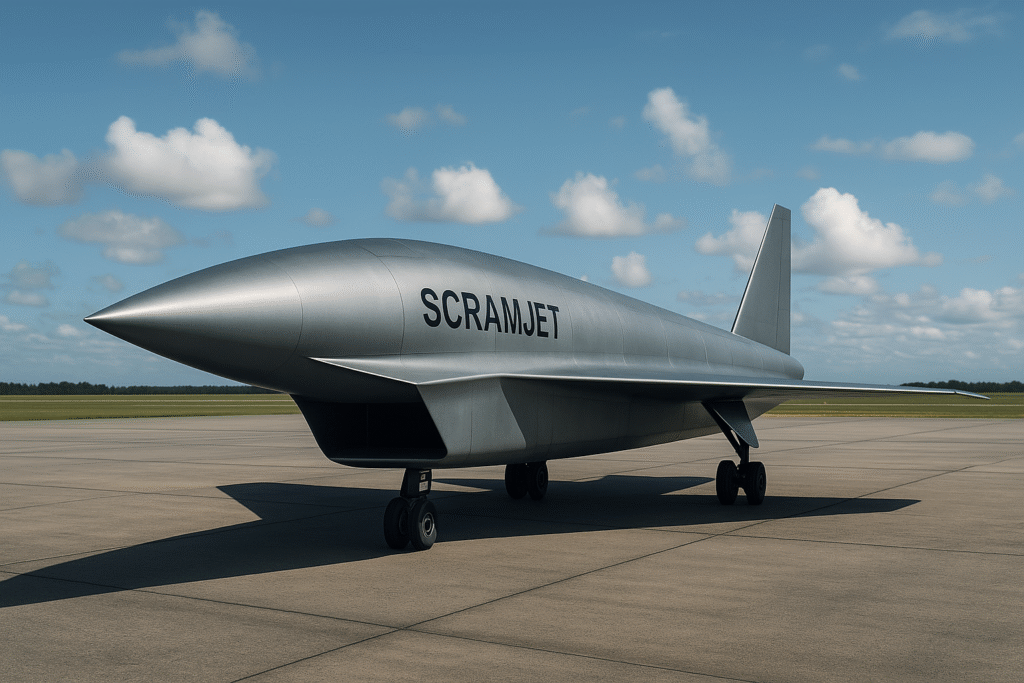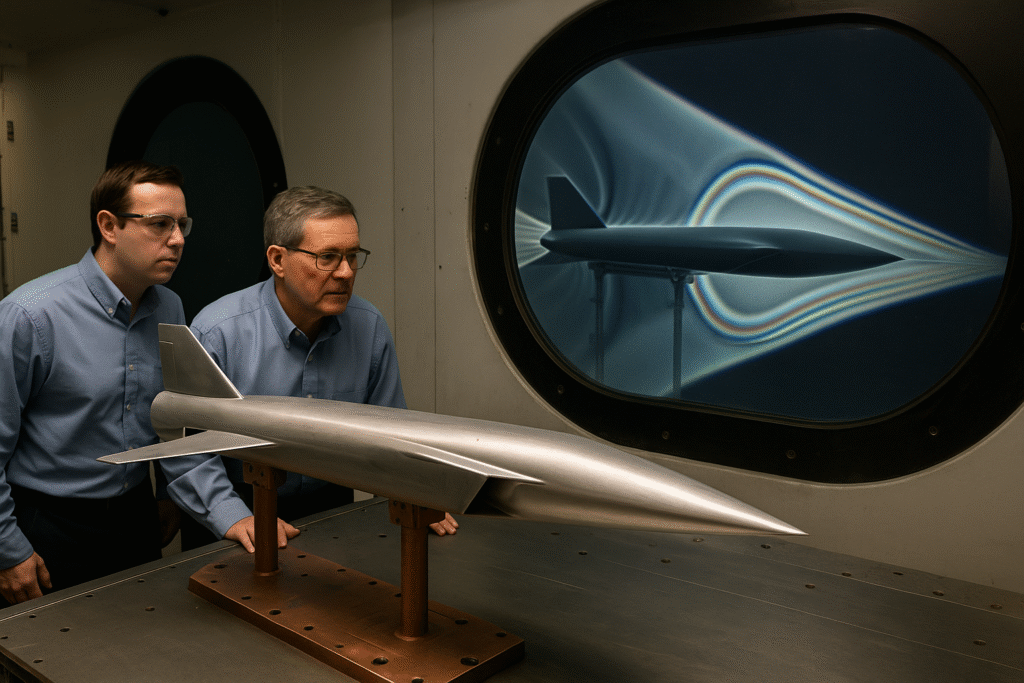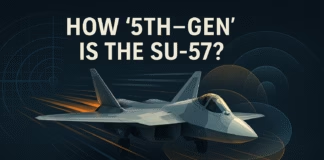Scramjets sound like science fiction—an engine with no compressor or turbine that lights fuel in a supersonic airstream and rides the atmosphere at Mach 5+. But behind the headline speed is a practical idea: use the air you’re flying through as oxidizer, skip heavy oxidizer tanks, and turn a launcher aircraft into the “first stage.” That air-breathing efficiency is why scramjets matter for long-range strike and rapid response.
Scramjet 101—why “supersonic combustion” is the whole trick
A scramjet is basically a carefully shaped duct. Forward motion rams air into an inlet, compressing it; the flow stays supersonic through the combustor, fuel is injected and ignited in milliseconds, and the expanding exhaust produces thrust. Compared with rockets, you trade brute force for clever aerodynamics and very high inlet temperatures—great for sustained atmospheric dash, not for launch from zero speed. For a clear primer, see NASA’s scramjet overview. grc.nasa.gov
From wind tunnels to sky: proof that it flies
The turning point was NASA’s X-43A. Boosted by a carrier aircraft and rocket to test speed, its hydrogen-fueled scramjet recorded history-making hypersonic flights and returned real, high-fidelity propulsion data engineers could trust. Those flights didn’t “win” hypersonics; they unlocked design tools, materials assumptions, and thermal models the field still uses. Read NASA’s summary of the X-43A program. NASA

What changed in the 2010s–2020s: flight data at weapons scale
After the research era came weapons-scale demos. DARPA and the U.S. Air Force flew the Hypersonic Air-breathing Weapon Concept (HAWC) multiple times, maturing inlet/combustor integration, high-temp materials, and guidance through the hypersonic corridor. The program’s final flight wrapped early 2023, handing industry and labs a deep dataset on affordable manufacturing and repeatable performance . darpa.mil
At the same time, government labs pushed for more frequent and cheaper experiments. AFRL’s BOLT II campaign focused on boundary-layer transition and turbulence—what turns smooth flow into heating spikes that can cook an airframe. That knowledge feeds directly into scramjet durability and guidance accuracy . afresearchlab.com
Why scramjets are hard (and how teams beat the “three bigs”)
1) Lighting and holding a flame in supersonic air. Residence time is milliseconds; injectors must mix fuel and air fast while flame-holding features prevent blowout. Hydrogen lights easily; hydrocarbon fuels win on logistics and density but need smart ignition strategies.
2) Heat—everywhere. At Mach 5–8, the inlet and cowl take brutal thermal loads. Designers mix high-temp composites, actively cooled metal structures, and “distributed heating budgets” so one hot spot doesn’t end the flight.
3) Geometry that does everything. The forebody shapes the inlet shock system; the combustor needs just-enough static pressure without choking; the nozzle must expand flow efficiently. Small changes ripple through the whole engine–airframe “waverider” design.
What scramjets are good for (and what they aren’t)
- Great for: sustained atmospheric sprint with high end-game maneuverability; using a carrier aircraft as the first stage; flexible basing (air-launched).
- Not great for: takeoff from a runway (they need initial speed); very low-altitude, high-drag flight for long periods; payloads that demand big volume or long loiter.
For readers who like platform context, our Experimental & Future Aircraft hub groups related propulsion stories, while Military Aircraft tracks doctrine and procurement angles.
How a flight happens: the simple, real-world sequence
- Air-launch and boost. A bomber or fighter drops the vehicle; a small solid booster accelerates it to scramjet “light.”
- Transition. The booster hands off to the inlet; doors/ramps set the shock train; ignition occurs.
- Powered cruise. Guidance rides a carefully chosen altitude–Mach corridor for heating and range.
- Terminal phase. The vehicle manages heating spikes as it maneuvers; accuracy depends on sensors, navigation filtering, and how well the airframe held its predicted shape under heat.
If you enjoy the engineering side—test tunnels, injector rigs, and combustor hardware—NASA Langley shares facilities built for exactly this work . Research Directorate

What’s next: from demonstrators to dependable inventory
Two threads dominate near-term progress: industrialization and ops integration. Industrialization means repeatable combustor hardware, supply chains for high-temp materials, and QA that survives unit-cost pressure. Integration means training crews, hardening mission planning, and building a maintenance rhythm for engines that see extreme cycles.
Pilots and planners will care less about Mach numbers and more about time-on-target options, standoff choices, and how many sorties per week the system can actually sustain. Those are the numbers that turn a tech demo into a useful, sustainable capability. For scenario walkthroughs and pilot-focused tech explainers, see our Simulator Technology hub . If you have a specific “what-if” to sanity-check, drop it in Captain’s Corner: Ask the Pilot —we’ll tailor an example route, climb profile, and weather window for your case.
Key takeaways
- Scramjets aren’t magic; they’re precise ducts that burn fuel in supersonic flow.
- We now have credible flight data—from NASA’s X-43A to DARPA/USAF HAWC—and maturing lab infrastructure to keep learning. NASAdarpa.milResearch Directorate
- The hardest problems are mixing/ignition, materials/thermal limits, and geometry coupling—and those are exactly where modern tools and tests are strongest.
- The mission value is speed + reach from air-launched platforms—useful when minutes matter.







[…] Want more details on hypersonic propulsion? Check out our breakdown: Can Hypersonic Aircraft Replace Satellites? […]
[…] Compare the F-35 to 4th-gen fighters like the F/A-18 (Internal – Aviation […]
[…] promising candidates because laminar flow gains persist throughout the profile. Our feature on Experimental & Future Aircraft covers how OEMs are testing these concepts with prototypes right […]